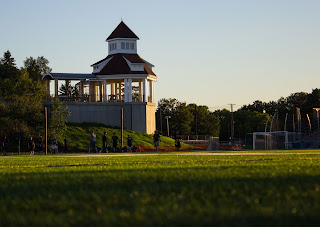The assignment given this week was to create two still-life photographs; one using all man-made objects, and one with predominantly natural objects. A still life photograph is one in which a group of objects are set on a foreground, in front of a background and photographed, taking into consideration lighting and composition. My professor gave positive feedback on both of my compositions overall; he said that the lighting was appropriate for both, and the composition of the objects within the photos are well placed. However, he said that both pieces are static, in that the objects are all fully within the frame of the picture, and the angle is pulled out far from the objects; if something were partially cropped out, it might lead the eye to wonder what is off camera.
Natural Object Still-Life
I posed the basket at an angle to make the objects more appealing, and placed a squash at the far end to add height to the photo. I placed the napkin at the near end of the basket, and coming out of it to create leading lines to draw the eye down. I then added the gold pine cones to add visual balance, and placed one lamp at an angle on the basket to create shadow, and therefore more visual interest, and one lamp onto the background. In the editing process, I made the background more smooth, and emphasized the shadows to echo the lines of the towel.
Man-Made Objects Still Life
I arranged these objects on a shelf that had the sun streaming into it to create a "dark", almost masculine mood. I thought this paired well with the set of antique books and the all-wood background. However, now, as I look at it, I wish that I had opened or tuned the book at the front, showing the pages, or possibly let one of the books in the back fall at an angle to add more visual interest.



















